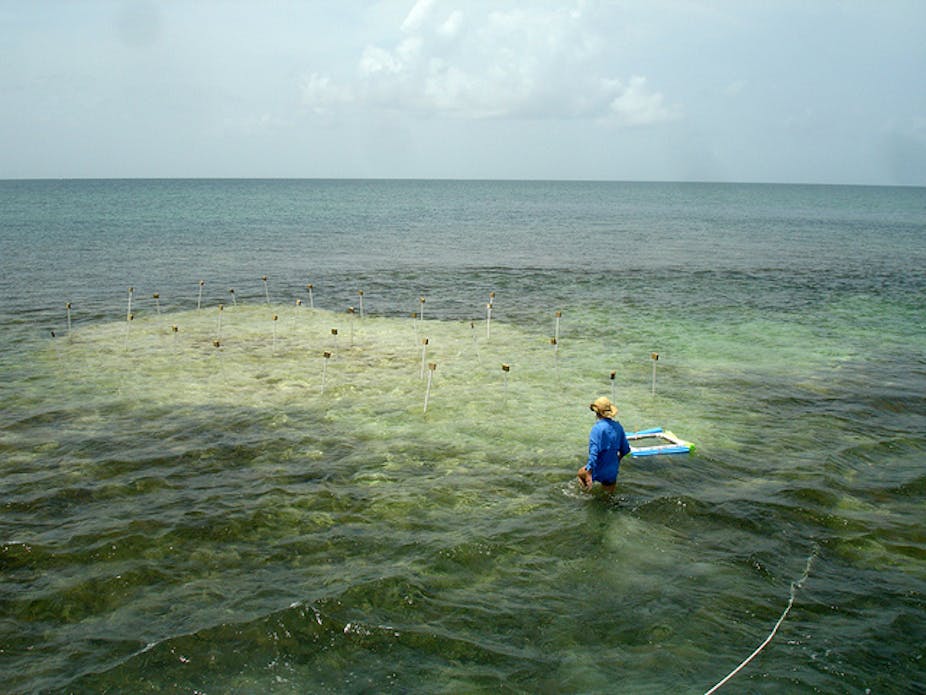Rising sea levels will lead to a drastic decline in seagrass stocks, a new study has found, but reducing water pollution may help offset the effects.
Seagrass is crucial to slowing climate change because of its remarkable capacity to absorb greenhouse gases, with some experts saying it is as important as forests in the fight against global warming.
The study, conducted by University of Queensland researchers published in the journal Global Change Biology, examined seagrass meadows along Queensland’s Moreton Bay.
The researchers calculated that seagrass there will decline by as much as 17% by 2100 if sea levels rise by 1.1 metres, unless water quality is improved or humans retreat from coastlines.
“Management to improve water quality will provide present and future benefits to seagrasses under climate change and should be a priority for managers seeking to compensate for the effects of global change on these valuable habitats,” the authors wrote in their study.
Threats
Seagrasses are important for maintaining biodiversity, habitats and offsetting carbon emissions. However, they will only flourish in a suitable [substrate](http://en.wikipedia.org/wiki/Substrate_(marine_biology) – the mud, sand and sediment in which seagrasses live.
The study looked at changes to water depth and clarity and the presence of roads, houses and other developments along inundated coastlines.
Seagrass meadows are under threat from urban development, declining water quality and increases in water depth due to sea level rise, which reduce the amount of light that can penetrate the water’s surface and reach the underwater foliage, they found.
“A scenario including the removal of impervious surfaces, such as roads and houses, from newly inundated regions, demonstrated that managed retreat of the shoreline could potentially reduce the overall decline in seagrass habitat to just 5%. The predicted reduction in area of seagrass habitat could be offset by an improvement in water clarity of 30%,” the researchers said in their paper.
Dr Megan Saunders, a researcher at the Global Change Institute at the University of Queensland and the study’s lead author, said the study’s findings should be used by government agencies who are responsible for managing coastal environments.
“If they want to maintain biodiversity, habitats for fisheries feeding grounds for turtle and dugong, and the key role that seagrass plays in sequestering carbon, they need to know how it’s likely to change over time,” Dr Saunders said.
“We are going to have to plan for the migration of coastal ecosystems, such as seagrass, due to sea level rise if we are to maintain the ecosystem services they provide,” she said.
Cutting our own legs off
Dr Peter Macreadie, Australian Research Council DECRA Fellow and a seagrass expert with the University of Technology, Sydney (UTS), said he was not surprised by the new findings.
“My colleagues and I at UTS predict, based on recent global estimates of seagrass decline, that if nothing is done to halt seagrass decline there will be none left in 50 years time,” he said.
“And that doesn’t take into account the effects of climate change; we just hit 400 ppm atmospheric CO2 for the first time in human history. The last time that happened was three million years ago, and it caused sea temperatures to go up by about 5 degrees Celsius and sea levels to rise as much as 40 metres.”
Dr Macreadie said that if nothing was done, the research suggests that seagrasses are in big trouble.
“These ecosystems provide immensely valuable ecosystem services to humanity, so not doing anything about their decline is equivalent to cutting our own legs off.”
Ugly ducklings
Carlos Duarte, Director of the University of Western Australia’s Oceans Institute, said the new study study offers a tool to managers to evaluate remedial actions for seagrass meadows.
“Whereas most studies have documented losses, this study takes a different approach at apportioning the stresses on seagrasses and projecting future losses in response to different scenarios, which is where the strength and innovation of the study rests,” said Dr Duarte, who was not involved in the study.
“Seagrass ecosystems are the ugly ducklings of marine conservation, yet they play key roles in sequestering CO2, protecting our coastlines and maintaining biodiversity.”

